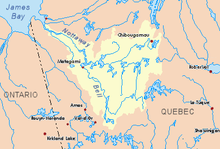| Bastien | |
|---|---|
 Watershed of Nottaway River | |
| Location | |
| Country | Canada |
| Province | Quebec |
| Region | Abitibi-Témiscamingue |
| Physical characteristics | |
| Source | Unidentified Lake |
| • location | Senneterre, La Vallée-de-l'Or Regional County Municipality (RCM), Abitibi-Témiscamingue, Quebec |
| • coordinates | 48°23′21″N 76°43′22″W / 48.38917°N 76.72278°W |
| • elevation | 452 m (1,483 ft) |
| Mouth | Mégiscane River, Faillon Lake |
• location | Senneterre, La Vallée-de-l'Or Regional County Municipality, Abitibi-Témiscamingue, Quebec |
• coordinates | 48°21′41″N 76°38′18″W / 48.36139°N 76.63833°W |
• elevation | 355 m (1,165 ft) |
| Length | 17.2 km (10.7 mi)[1] |
| Basin features | |
| Tributaries | |
| • left |
|
The Bastien River is a tributary of the north shore of Faillon Lake which is crossed by the Mégiscane River. The Bastien River flows into the town of Senneterre in La Vallée-de-l'Or Regional County Municipality (RCM), in the administrative region of Abitibi-Témiscamingue, in Quebec, Canada.
The course of the river successively crosses the townships of Martin, Valets and Faillon.
The Bastien River flows entirely in forest territory, generally towards the South. Forestry is the main economic activity of this hydrographic slope; recreational tourism activities, second. Road R0806 (Penetration Road) cuts from east to west the lower part of the hydrographic slope of the Bastien River; secondary and forest roads also serve the entire hydrographic slope. The surface of the river is usually frozen from mid-December to mid-April.
- ^ "Atlas of Canada". atlas.nrcan.gc.ca. Archived from the original on 2008-10-14. Retrieved 2018-01-27.